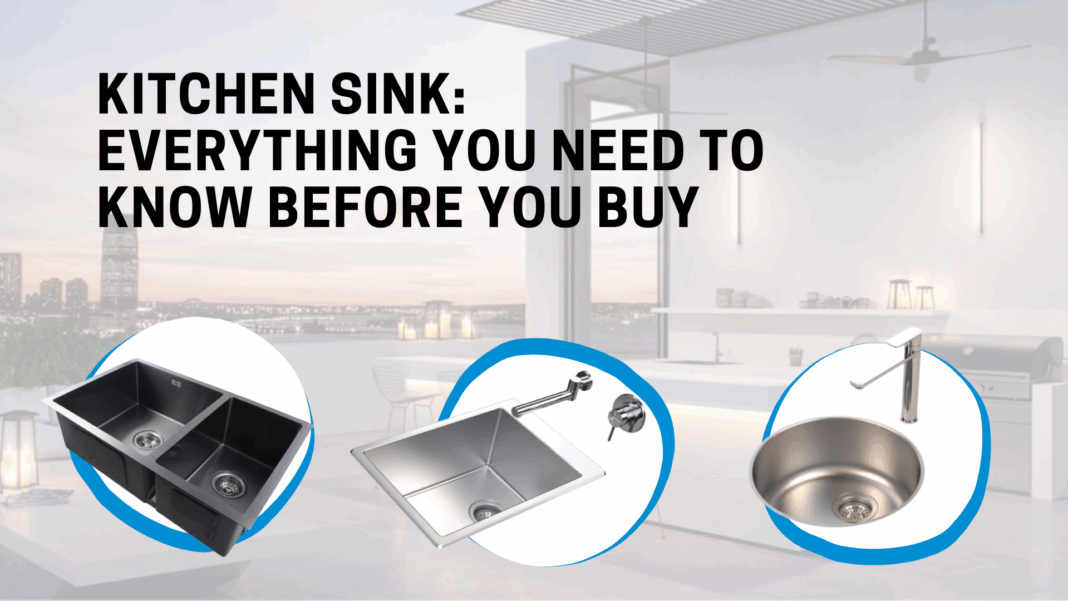If you’re redoing your kitchen or building one from scratch, chances are you’ve already spent hours thinking about cabinets, countertops, lighting, and appliances. But here’s something most people overlook until the last minute: the kitchen sink. And yet, it’s one of the hardest-working parts of the kitchen.
Let’s start with the things you need to know.
1. Size and Depth: More Important Than You Think
When it comes to kitchen sinks, size does matter. A luxurious-looking big sink is of no use if your overall kitchen is small. In the same way, a small sink will be a disaster if you are planning a kitchen renovation. So, you need to make sure that the kitchen sinks fit right in it.
- Most sinks fall between 22 and 33 inches in width
- Some deeper options usually range from 6 to 12 inches
Consider how you utilise your kitchen. If you cook often, entertain guests, or deal with oversized cookware, a slightly bigger and deeper sink might be well worth it.
But what about the design?
2. Undermount or Something Fancy?
Your countertop and installation budget will play a big role here. There are three main styles you’ll come across:
- Top-mount (drop-in) sinks are easy to install and usually more affordable. The rim is on the corner. So, they are quite difficult to clean as compared to others. You need to keep this in mind.
- Undermount sinks attach beneath the counter, giving you that clean, seamless look. Great for stone or granite counters, but installation needs to be precise.
- Farmhouse (apron front) is yet another option that brings in a rustic vibe. However, custom cabinetry is usually a good fit for this.
Your sink choice should complement the materials and layout of your kitchen installation.
3. Material: It’s Not Just About Steel
Most people go straight for stainless steel, and for good reason. It’s durable, easy to clean, and works with almost any kitchen style. But it’s not your only option.
- Stainless steel: Resistant to stains and heat, but it can scratch or show water spots. Thicker gauge steel (16 or 18 gauge) will be quieter and sturdier.
- Granite composite: Tough, good-looking, and available in different colours. Resists scratches and chips, but it’s heavier and may need extra support.
- Ceramic or fireclay: Classic and charming, especially for farmhouse-style kitchens. But they can crack if you drop something heavy.
- Cast iron with enamel: Glossy, colourful, and built to last, but heavy and needs careful handling during installation.
Think about your kitchen’s style, how much wear and tear your sink will see, and how much time you want to spend cleaning it. This brings us to the number of bowls.
4. Number of Bowls: One, Two, or Even Three?
Back in the day, double-bowl sinks were standard in most homes. These days, more people are switching to single-bowl sinks for their sleek look and roominess.
- Single-bowl sinks give you more space for large pots and baking trays. Simple and efficient if you mostly rely on a dishwasher.
- Double-bowl sinks let you multitask, soak veggies on one side, and rinse dishes on the other. Great if you hand-wash often.
- Triple-bowl sinks exist, but unless you’re running a restaurant kitchen, they’re probably overkill for home use.
Choose based on how you work in your kitchen. If you’re constantly juggling different tasks, two bowls might just make your life easier.
5. Draining and Sloping: Yes, It Matters
This is something you might not think about until you end up with standing water at the bottom of your sink. A well-designed sink should have a slight slope that lets water flow easily into the drain.
Also, check the position of the drain:
- Centre drains are common and work well, but can get in the way when you’re stacking dishes.
- Rear-offset drains leave more usable space in the base cabinet and make under-sink plumbing a little easier to access.
6. Noise Levels: Quieter Is Better
You’d be surprised how loud a sink can get, especially if it’s a cheaper, thinner stainless steel one. Look for sinks with sound-deadening pads or undercoating. These help reduce the noise of water hitting the bowl or pans clanging around.
This might feel like a luxury detail, but if your kitchen is part of an open-plan living area, a quiet sink makes a noticeable difference.
7. Maintenance: Pick Something That Fits Your Daily Life
It makes no sense to keep cleaning the sink until it shines, no matter how good the sink is. So, you need to make sure that you are going with the sinks that are easy to maintain for you.
There are multiple things you can keep in mind here.
Here are some of the most important tips you can use.
- Go for smooth and rounded corners instead of other types of sharp edges; they’re way easier to wipe down
- Avoid overly textured surfaces that trap food bits and grime
- Look for materials that don’t stain easily or show water spots
Final Thoughts: Pay Attention to Kitchen Sinks
The kitchen sink might seem like just another box in your checklist, but it matters a lot when it comes to design and overall functionality. So, make sure you give enough time and effort to it.



